All India Radio
All India Radio (AIR), officially known since 1957 as Akashvani (literary meaning "Voice from the Sky"), is the national public radio broadcaster of India and is a division of Prasar Bharati. It was established in 1936.[2]
 | |
.jpg.webp) Headquarters at Sansad Marg, New Delhi | |
| Type | Government organisation |
|---|---|
| Country | India |
| Headquarters | Akashvani Bhavan Sansad Marg, New Delhi – 110001, Delhi, India |
| Motto | Bahujanahitaya Bahujanasukhaya (बहुजनहिताय बहुजनसुखाय)[1] |
| Ownership | |
| Owner | Prasar Bharati |
| History | |
| Launch date | 23 July 1927 |
| Coverage | |
| Availability | National International |
| Links | |
| Webcast | Live Stream |
| Website | All India Radio, News on AIR |
It is the sister service of Prasar Bharati's Doordarshan, an Indian television broadcaster.[3] Headquartered in the Akashvani Bhavan building in New Delhi, it houses the Drama Section, the FM Section, the National Service, and is also home to the Indian television station Doordarshan Kendra, (Delhi).
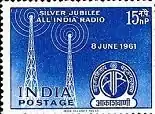
All India Radio is the largest radio network in the world, and one of the largest broadcasting organisations in the world in terms of the number of languages broadcast and the spectrum of socio-economic and cultural diversity it serves. AIR's home service comprises 420 stations located across the country, reaching nearly 92% of the country's area and 99.19% of the total population. AIR originates programming in 23 languages and 179 dialects.[4]
Etymology
Ākāśavānī (आकाशवाणी) is a Sanskrit word meaning 'celestial announcement' or 'voice from the sky/heaven'. In Hinduism, Jainism and Buddhism, Akashvanis are often featured in stories as a medium of communication from heaven to mankind.
When the Indian State Broadcasting Service (ISBS) was renamed All India Radio, Rabindranath Tagore rechristened it as Akashvani, the voice that comes over from the skies, through a poem penned for the inauguration of Calcutta’s shortwave service.[5][6]
'Akashvani' was also used in the context of radio by M. V. Gopalaswami in 1936 after setting up India's first private radio station in his residence, "Vittal Vihar" (about two hundred yards from AIR's current Mysore radio station).[7] Akashvani was later given as All India Radio's on-air name in 1957; given its literal meaning in Sanskrit, it was believed to be a more than suitable name for a broadcaster.
History
Broadcasting began in June 1923 during the British Raj with programmes by the Bombay Presidency Radio Club and other radio clubs. According to an agreement on 23 July 1927, the private Indian Broadcasting Company Ltd (IBC) was authorized to operate two radio stations: the Bombay station which began on 23 July 1927, and the Calcutta station which followed on 26 August 1927. The company went into liquidation on 1 March 1930. The government took over the broadcasting facilities and began the Indian State Broadcasting Service (ISBS) on 1 April 1930 on an experimental basis for two years, and permanently in May 1932 it then went on to become All India Radio on 8 June 1936.[2]
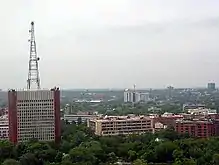
In August 1947, All India Radio hired its first female newsreader, Saeeda Bano, who read the news in Urdu.[8]
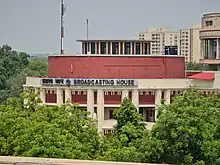
On 1 October 1939, the External Service began with a broadcast in Pushtu. It was intended to counter radio propaganda from Germany directed at Afghanistan, Persia and Arab nations. 1939 also saw the opening of the Dhaka station of Eastern India, in what is now Bangladesh. This station catered and nurtured the pioneers of Bengali intellectuals. The foremost among them, Natyaguru Nurul Momen, became the trail-blazer of the talk-show in 1939. He wrote and directed the first modern radio-play for this station in 1942. When India became independent in 1947, the AIR network had only six stations (Delhi, Bombay, Kolkata, Madras, Lucknow, and Tiruchirappalli). The three radio stations at Lahore, Peshawar and Dhaka remained in what became Pakistan after the division. The total number of radio sets in India at that time was about 275,000. On 3 October 1957, the Vividh Bharati Service was launched, to compete with Radio Ceylon. Television broadcasting began in Delhi in 1959 as part of AIR, but was split off from the radio network as Doordarshan on 1 April 1976.[9] FM broadcasting began on 23 July 1977 in Chennai, and expanded during the 1990s.[10]
Deccan Radio (Nizam Radio 1932), the first radio station in Hyderabad State (now Hyderabad, India), went live on air on 3 February 1935. It was launched by Mir Osman Ali Khan the seventh Nizam of Hyderabad with a transmitting power of 200 Watts. On 1 April 1950, Deccan Radio was taken over by the Indian Government, and in 1956 it was merged with All India Radio (AIR). Since then, it has been known as AIR-Hyderabad (100 kW).[11]
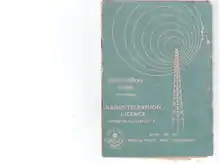
Domestic services
AIR has many services in a number of languages, each serving different regions across India.
Vividh Bharati
Vividh Bharati is one of the best-known services of All India Radio. Its name roughly translates as "Diverse Indian". It is also known as the Commercial Broadcasting Service or CBS. Commercially, it is the most accessible AIR network and is popular in Mumbai and other large cities. Vividh Bharati offers a wide range of programmes including news, film music, short plays, music and comedy. It operates on different medium wave-band as well as FM frequencies in each city. Vividh Bharati service started in 1957.
Some programmes broadcast on Vividh Bharati are:
- Hawa-mahal: Radio plays based on novels and plays
- Santogen ki mehfil: Comedy
- Aaj ke fankar: description of life and works of a film artist
- Chhayageet: songs of announcer's choice with impeccable scripting
Central Sales Unit
Central Sales Unit (CSU) is single window services of All India Radio for commercial purposes. Its name roughly translates as "Centralised Sales Unit". It is situated in Mumbai. http://prasarbharati.gov.in/AIRCSUContact.php
Regional services
The headquarters of the Regional Deputy Directors General are located in Delhi and Chandigarh (NR), Lucknow and Bhopal (CR), Guwahati (NER), Kolkata (ER), Mumbai and Ahmedabad (WR), Chennai and Bangalore (SR).[14] All frequencies are in kHz, unless otherwise noted. Most of the channels are also available online.
| City | Frequency | City | Frequency | City | Frequency |
|---|---|---|---|---|---|
| Agra | 1530 | Ajmer | 603 | Allahabad | 1026 |
| Almora | 999 | Barmer | 1458 | Bikaner | 1395 |
| Chairhara (Budgam) | 1485 | Delhi A | 819 | Delhi B | 666 |
| Delhi C (Vividh Bharti) | 1368 | Delhi D (Yuv-vani) | 1017 | Delhi (National Channel) | 1215 |
| Diskit | 1602 | Faizabad | 1485 | Gorakhpur | 909 |
| Jaipur A | 1476 | Jalandhar A | 873 | Jalandhar B | 702 |
| Jammu A | 990 | Jodhpur A | 531 | Kalpa (Kinnaur) | 1584 |
| Kargil A | 684 | Kargil B | 1584 | Khalsi | 1485 |
| Kota | 1413 | Kupwara | 1350 | Leh | 1053 |
| Lucknow A | 747 | Lucknow C | 1278 | Mathura | 1584 |
| Najibabad | 954 | Naushera | 1089 | Nyoma | 1485 |
| Padam | 1584 | Pauri | 1602 | Pithoragarh | 1602 |
| Rampur | 891 | Rohtak | 1143 | Shimla | 774 |
| Budgam | 1116 | Budgam A | 1224 | Srinagar C | 918 |
| Tiesuru | 1602 | Udaipur | 1125 | Uttarkashi | 1602 |
| Varanasi A | 1242 | Sawai Madhopur | FM 101.5 MHz | Raebareli | FM 102.8 MHz |
| City | Frequency | City | Frequency |
|---|---|---|---|
| Agartala | 1269 | Guwahati A | 729 |
| Shillong | 864 | Imphal | 882 |
| City | Frequency | City | Frequency | |
|---|---|---|---|---|
| Bhagalpur | 1458, 1206 | Chinsurah ((Akashvani Maitree), 1 MegaWatt Transmitter Capacity) | 594 & 1134 | |
| Cuttack A | 972 | Darbhanga | 1296 | |
| Jamshedpur | 1584 | Gitanjali (Kolkata A)(200 KW Transmitter Capacity) | 657 | |
| Sanchayita (Kolkata B)(100 KW Transmitter Capacity) | 1008 | Kolkata C (Vividh Bharati) | 1323 kHz Medium Wave as well as 101.8 MHZ FM | |
| Patna A | 621 | Ranchi A | 549 | |
| Muzaffarpur A | FM 100.1 MHz | Muzaffarpur B | FM 106.4 MHz | |
| Kolkata (FM Rainbow) (20 KW Transmitter Capacity) | FM 107.0 MHz | Kolkata (FM Gold)(20 KW Transmitter Capacity) | FM 100.2 MHz | |
| Kurseong | 1440 kHz as well as FM 102.3 MHZ (5 KW Transmitter Capacity) | Siliguri | 711 kHz (200 KW DRM Transmitter Capacity) | |
| Santiniketan (Bolpur) | FM 103.1 MHz (3 KW Transmitter Capacity) | Murshidabad (6 KW Transmitter Capacity) | FM 102.2 MHz |
| City | Frequency | City | Frequency |
|---|---|---|---|
| Ahmedabad A | 846 | Aurangabad | 1521 |
| Bhopal A | 1593 | Chhindwara | FM 102.2 MHz |
| Chhatarpur | 675 | Gwalior | 1386 |
| Indore A | 648 | Jabalpur A | 801 |
| Mumbai A | 1044 | Mumbai B (Asmita Marathi) | 558 |
| Mumbai C (Vividh Bharati) | 1188 | Nagpur A | 585 |
| Nagpur B (National Channel, 1 MW) | 1566 | Panaji A | 1287 |
| Panaji B (Vividh Bharati) | 828 | Pune A | 792 |
| Rajkot A | 810 | Ratnagiri | 1143 |
| Solapur | 1602 | Sangli | 1251 |
| Parbhani A | FM 102.0 MHz | Jabalpur Vividh Bharati | 102.9 |
| Mysore | FM 100.6 MHz | Jalgaon | 963 |
| City | Frequency | City | Frequency |
|---|---|---|---|
| Bengaluru | 612 kHz | Bengaluru(Vivida Bharati) | 102.9 MHz |
| Bangalore(Rainbow FM) | 101.3 MHz | Bhadravati | 675 kHz |
| Dharwad | 765 kHz | Dharwad FM | 103.0 MHz |
| Hassan | 1107 kHZ | Kalburagi | 1107 kHz |
| Mangaluru | 1089 kHz | Mangalore FM | 100.3 MHz |
| Madikeri FM | 103.1 MHz | Sringeri FM | 101 MHz |
| Vijayawada | 103.4 MHz |
External services
The external services of All India Radio are broadcast in 27 languages to countries outside India via high-power shortwave band broadcasts. Medium wave is also used to reach neighbouring countries. In addition to broadcasts targeted at specific countries by language, there is a General Overseas Service broadcasting in English with 8+1⁄4 hours of programming each day aimed at a general international audience. The external broadcasts were begun on 1 October 1939 by the British government to counter the propaganda of the Nazis directed at the Afghan people. The first broadcasts were in Pashto, beamed to Afghanistan and the North-West Frontier Province. Broadcasts soon began in other languages including: Dari, Persian, Arabic, English, Burmese, Japanese, Chinese, Malay and French. The external services broadcast in 16 foreign and 11 Indian languages, with a total programme output of 70¼ hours per day on medium and shortwave frequencies.
| Location | Number of transmitters | kW | Frequency | DRM ! |
|---|---|---|---|---|
| Aligarh (HPT) | 4 | 250 | ||
| Bengaluru (SPT) | 6 | 500 | 100 kW | |
| Chennai (Madras) | 1 | 100 | 720 kHz | MW |
| Gorakhpur | 1 | 50 | ||
| Guwahati | 1 | 50 | ||
| Jalandhar (Goraya) | 1 | 300 | 702 kHz | MW |
| Khampur-Delhi (HPT) | 7 | 250 | ||
| Khampur-Delhi (SPT) | 2 | 500 | ||
| Kingsway-Delhi | 3 | 50 | ||
| Kingsway-Delhi | 2 | 100 | ||
| Kolkata-Chinsurah/Mogra (SPT) | 1 | 1000 | 1134 kHz and 594 kHz (Kolkata – A) | 1142 kHz MW |
| Mumbai (Malad) | 1 | 100 | ||
| Nagpur (SPT) | 1 | 1000 | 1566 kHz | MW |
| Panaji (HPT) | 2 | 250 | ||
| Rajkot (SPT) | 1 | 1000 | 1071 kHz AIR URDU | 1080 kHz (2 MW) Vividha Bharti |
| Tuticorin | 1 | 200 | 1053 kHz | MW |
Two high powered FM stations of All India Radio are being installed in Amritsar and Fazilka in the Punjab to supplement the programmes broadcast from transmitters operating from Jalandhar, New Delhi, Chandigarh and Mumbai and to improve the broadcast services during unfavourable weather conditions in the border regions of Punjab.
Today, the External Services Division of All India Radio broadcasts daily with 57 transmissions with almost 72 hours or programming covering over 108 countries in 27 languages, of which 15 are foreign and 12 Indian. The foreign languages are: Arabic, Baluchi, Burmese, Chinese, Dari, French, Indonesian, Persian, Pushtu, Russian, Sinhala, Swahili, Thai, Tibetan and English (General Overseas Service). The Indian languages are Bengali, Gujarati, Marathi, Konkani, Kashmiri, Hindi, Kannada, Malayalam, Nepali, Punjabi, Saraiki, Sindhi, Tamil, Telugu and Urdu.
The longest daily broadcast is the Urdu Service to Pakistan, around the clock on DTH (direct-broadcast satellite) and on short- and medium wave for 121⁄4 hrs. The English-language General Overseas Service is broadcast 81⁄4 hours daily. During Hajj, there are special broadcasts beamed to Saudi Arabia in Urdu. AIR is planning to produce programmes in the Baluchi language.[16]
The external services of AIR are also broadcast to Europe in DRM (Digital Radio Mondiale) on 9950 kHz between 1745 and 2230 UTC. These external transmissions are broadcast by high-power transmitters located at Aligarh, Bengaluru, Chennai, Delhi, Gorakhpur, Guwahati, Mumbai and Panaji on shortwave and from Jalandhar, Kolkata, Nagpur, Rajkot and Tuticorin on medium wave. Soon All India Radio Amritsar will also start a booster service on the FM band. Some of these transmitters are 1000 kW (1 MW) or 500 kW. Programmes are beamed to different parts of the world except for the Americas and the reception quality is very good in the target areas. In each language service, the program consists of news, commentary, a press review, talks on matters of general or cultural interest, feature programmes, documentaries and music from India and the target region. Most programmes originate at New Broadcasting House on Parliament Street in New Delhi, with a few originating at SPT Bengaluru, Chennai, Hyderabad, Jalandhar, Kolkata, HPT Malad Mumbai, Thiruvananthapuram and Tuticorin.
The External Services Division of AIR is a link between India and rest of the world, especially in countries with Indian emigrants and people of Indian origin. It broadcasts the Indian point of view on matters of national and international importance, and demonstrates the Indian way of life through its programs. QSL cards (which are sought-after by international radio hobbyists) are issued to radio hobbyists by AIR in New Delhi for reception reports of their broadcasts.
Direct-To-Home
Direct-to-home (DTH) service is a satellite broadcast service in which a large number of radio channels are digitally beamed down over a territory from a high-power satellite. AIR broadcasts various national and regional stations available to listen on DD Free Dish. The DTH signals can be received directly at homes using a small-sized dish receiver unit containing a dish antenna installed on a building's rooftop or on a wall facing clear south and one indoors.[17] DTH service is offered on twenty one channels via Insat.
National
- Vividh Bharati – Hindi Music Radio
- AIR FM Rainbow India – Hindi & English Music Radio
- AIR FM Gold Delhi – Classic Hindi Music & News Radio
- AIR Live News 24×7 – Hindi & English News Radio
- AIR Urdu – Urdu Entertainment Radio
- Raagam – Indian Classical Music Radio
- Gyan Vani – Hindi & English Educational Radio
Regional
- AIR Assamese
- AIR Bangla
- AIR Gujarati
- AIR Hindi
- AIR Kannada
- AIR Malayalam
- AIR Marathi
- AIR Odia
- AIR Punjabi
- AIR Tamil
- AIR Telugu
- AIR Agartala – Bengali & Kokborok
- AIR Aizawl – Mizo
- AIR Bhopal – Hindi
- AIR Dehradun – Hindi
- AIR Gangtok – Nepali
- AIR Imphal – Manipuri
- AIR Itanagar – Hindi & Nyishi
- AIR Jaipur – Hindi & Rajasthani
- AIR Jammu – Dogri & Hindi
- AIR Kohima – Nagamese & English
- AIR Leh – Ladakhi
- AIR Lucknow – Hindi & Urdu
- AIR North East – Hindi & English
- AIR Panaji - Konkani & Marathi
- AIR Patna – Hindi
- AIR Port Blair - Hindi
- AIR Puducherry - Tamil
- AIR Raipur – Hindi & Chhattisgarhi
- AIR Ranchi – Hindi
- AIR Rohtak – Hindi
- AIR Shillong – Khasi & English
- AIR Shimla – Hindi
- AIR Srinagar – Kashmiri & Urdu
- AIR Vijayawada – Telugu
Online services
- AIR Live News
- KASHMIR ONLINE RADIO
- Vividh Bharati
- FM Gold Delhi
- FM Rainbow Delhi
- AIR Urdu
- Raagam
- AIR Gujarati
- AIR Marathi
- AIR Punjabi
- AIR Malayalam
- AIR Tamil
- AIR Telugu
- AIR Kannada
- AIR Bangla
- AIR Jammu
- AIR Odia
- AIR Assamese
- AIR North East
- FM Tragopan Kohima
- FM Rainbow Goa
- AIR Shimla
- AIR Bhuj
- AIR Indore
- AIR Mysuru
- AIR Jodhpur
- Amrutvarshini
- Vividh Bharati Bengaluru
- FM Rainbow Kannada Kaamaanbilu
- AIR Bengaluru
- Sun City FM Jodhpur
- AIR Pune
- AIR Rohtak
- FM Rainbow Lucknow
- AIR Jabalpur
- AIR Bhopal
- FM Rainbow Mumbai
- FM Gold Mumbai
- Samvadita Mumbai
- AIR Aadilabad
- AIR Jaipur
- AIR Varanasi
- AIR Raipur
- AIR Sangli
- AIR Rajkot
- AIR Nagpur
- AIR Prayagraj
- AIR Patna
- AIR Patiala
- AIR Mhadei Panaji
- AIR Gorakhpur
- AIR Hassan
- AIR Dehradun
- AIR Solapur
- AIR Kota
- AIR Madurai
- AIR Kolhapur
- AIR Suratgarh
- FM Rainbow Visakhapatnam
- AIR Kurnool
- AIR Bikaner
- AIR Kochi
- AIR Calicut
- AIR Mathura
- AIR Agra
- FM Rainbow Vijayawada
- AIR Vijayawada
- AIR Kannur
- FM Ananthapuri
- AIR Lucknow
- AIR Mount Abu
- AIR Dharwad
- AIR Chandigarh
- AIR Chitradurga
- AIR Manjeri
- AIR Aurangabad
- AIR Surat
- AIR Tirupati
- AIR Kodaikanal
- AIR Alwar
Other services
Digital Radio Mondiale
Details of the Digital Radio Mondiale (DRM) transmissions and frequencies are as follows:
- 0130–0230 UTC on 11715 kHz Nepali (Nepal)
- 0315–0415 UTC on 15185 kHz Hindi (E. Africa, Mauritius)
- 0415–0430 UTC on 15185 kHz Gujarati (E. Africa, Mauritius)
- 0430–0530 UTC on 15185 kHz Hindi (E. Africa, Mauritius)
- 1300–1500 UTC on 15050 kHz Sinhala (Sri Lanka)
- 1615–1715 UTC on 15140 kHz Russian (E. Europe)
- 2245–0045 UTC on 11645 GOS-I English (NE Asia)
Above transmissions are in addition to following existing DRM txn's:
- 0900–1100 on 6100 Vividh Bharati, DRM NVIS
- 1745–1965 UTC on 9950 English (W. Europe)
- 1945–2045 UTC on 9950 Hindi (W. Europe)
- 2045–2630 UTC on 9950 English (W. Europe)
News-on-phone
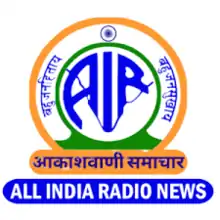
All India Radio launched news-on-phone service on 25 February 1998 in New Delhi; it now has service in Chennai, Mumbai, Hyderabad, Indore, Patna and Bangalore. The service is accessible through Subscriber trunk dialling (STD), International Direct Dialing (ISD) and local calls. There are plans to establish the service in 11 additional cities including: Ahmedabad, Bhopal, Guwahati, Gwalior, Jabalpur, Jaipur, Kolkata, Lucknow, Ranchi and Shimla. English and Hindi hourly news bulletins may be heard live.[18] News in MP3 format may be directly played from the site, and filenames are time-stamped. AIR news bulletins are available in nine regional languages: Tamil, Kannada, Gujarati, Bengali, Marathi, North East, Punjabi, Telugu and Urdu.
Documentaries
There is a long tradition of broadcasting documentary features on AIR. There is great interest in radio documentaries, particularly in countries like India, Iran, South Korea and Malaysia. The most prominent broadcaster of English Features was Melville de Mellow, and of Hindi Features, Shiv Sagar Mishra. This format has been revived by AIR producers across India because of its flexibility, its relative low cost to produce, its messaging potential and its creative potential.
Central Drama Unit
AIR's Central Drama Unit (CDU) is responsible for the national broadcast of plays. Plays produced by the CDU are translated and produced by regional stations. Since its inception in the 1960s, the unit has produced more than 1,500 plays, and the CDU houses a repository of old scripts and productions. The National Programme of Plays is broadcast by the CDU on the fourth Thursday of each month at 9.30 pm. Each play included in the National Programme of Plays is produced in 22 Indian languages and broadcast at the same time by all regional and national network stations. The CDU also produces Chain Plays, half-hour dramas broadcast in succession by a chain of stations.
Social Media Cell
The News Service Division's Social Media Cell was established on 20 May 2013 and is responsible for providing AIR news on new media platforms such as websites, Twitter, Facebook, and SMS.
Gallery
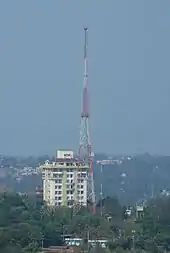
 Kolkata Centre of All India Radio, West Bengal.
Kolkata Centre of All India Radio, West Bengal. Akashvani Bhawan Iin Sansad Marg, New Delhi
Akashvani Bhawan Iin Sansad Marg, New Delhi Emblem Of AIR
Emblem Of AIR
See also
- Radio in India
- 106.4 FM Radio Gold
- Telugu Radio
- Radio Kashmir
- Telecommunications in India
References
- "Mission of AIR". allindiaradio.gov.in. Retrieved 4 September 2021.
- "Milestones of AIR (official website)". All India Radio. Retrieved 13 January 2013.
- Home page: All India Radio prasarbharati.gov.in. Retrieved 4 September 2021
- "AIR Home". prasarbharati.gov.in. Retrieved 28 February 2020.
- "Riding the waves, a shared history". Indian Express.
- Chandrika Kaul (2014). 'Invisible Empire Tie': Broadcasting and the British Raj in the Interwar Years. pp. 123–171. doi:10.1057/9781137445964_4. ISBN 978-1-137-44596-4.
- "Mysore Akashavani is now 75 years old". Business Standard.
- Najib, Rihan. "To end the news, the headlines again: The life and times of Saeeda Bano". @businessline. Retrieved 4 March 2021.
- "AIR Manual, Chapter 1: History of All India Radio" (PDF). Archived from the original (PDF) on 17 September 2010.
{{cite journal}}: Cite journal requires|journal=(help) - "Milestones of AIR". All India Radio. Archived from the original on 12 June 2010.
- "The Long and Interesting Story of All India Radio, Hyderabad–Part 2". Wavescan-NWS78. 15 August 2010.
- "Primary Channel Services". allindiaradio.gov.in. Retrieved 30 July 2018.
- "National Channel". Archived from the original on 1 October 2011. Retrieved 2 May 2014.
- "All India Radio". Know India. Archived from the original on 3 September 2011. Retrieved 15 October 2011.
- "Annual Report 2018-2019, page 193" (PDF). Retrieved 21 March 2021.
- IANS (31 August 2016). "All India Radio to revamp Baluchi language programme". Business Standard.
- "DD Free Dish (DTH)". ddindia.gov.in. Archived from the original on 19 July 2016. Retrieved 21 July 2016.
- "Prasar Bharati". Retrieved 17 October 2011.
External links
- All India Radio Official web-site
- All India Radio Commercial Broadcasting Service Vividh Bharati On Line
- All India Radio Commercial Broadcasting Service Vividh Bharati On Line Archived 22 October 2014 at the Wayback Machine
- All India Radio General Overseas Service / External Services Division
- All India Radio General Overseas Service / External Services Division (English)
- Know India: Radio
- All India Radio (AIR) Station Frequencies (National/International)
- Children's wing of All India Radio